| Warriors of the Visual Studio, Assemble! | |||||||||||||||||||||||||||||
|
If you've recently purchased
Assembly Language for Intel-Based Computers, 5th edition, you probably want to get the software set up so you can start working. This tutorial should make the process easier. If you're in a hurry to get started, you only need to read Item 1.
Found an error in this document? Please email me immediately. Except where noted, all instructions in this document apply equally to Visual Studio and Visual C++ Express. Required Setup for 32-bit ApplicationsFirst, you must install some version of Visual Studio or Visual C++ Express:
You can verify that the Microsoft Assembler is installed by looking for the file ml.exe in the /vc/bin folder of your Visual Studio installation directory, such as c:/Program Files/Microsoft Visual Studio 9.0/vc/bin. Downloading and installing the Microsoft Assembler 8.0: Visit Microsoft's MASM 8.0 download site. Follow the download and installation instructions on the Microsoft page. If the link is broken, please let us know by email. Note that this MASM download only works with Visual C++ 2005 Express. MASM 8.0 is almost identical to MASM 9.0. Next: Install the Book's Example ProgramsClick this link to get the latest copy of the book's link libraries and example programs. The examples are stored in a self-extracting archive file that automatically extracts to the c:/Irvine folder. Unless you have some objection to using that location, do not alter the path. (Lab managers: you can designate c:/Irvine directory as read-only.) If you plan to change the installation location, read our instructions relating to changing project properties. The folllowing files will be copied into the c:/Irvine directory:
A subdirectory named Examples will contain all the example programs shown in the book. Building a Sample Assembly Language ProgramPreliminary Step: Set Tab Size to 5Start Visual C++ Express, and select Options from the Tools menu. Select Text Editor, Select All Languages, and select Tabs:
Set the Tab Size and Indent Size to 5. Opening a ProjectVisual Studio and Visual C++ Express require assembly language source files to belong to a project, which is a kind of container. A project holds configuration information such as the locations of the assembler, linker, and required libraries. A project has its own folder, and it holds the names and locations of all files belonging to it. We have created a sample project folder in the c:/Irvine/Examples directory, and its name is Project_Sample. Do the following steps, in order:
You should see the following program in the editor window:
Later, we'll show you how to copy this program and use it as a starting point to write your own programs. Build the ProgramNext, you will build (assemble and link) the sample program:
In the output window at the bottom of the screen, you should see messages similar to the following, indicating the build progress:
If you do not see these messages, the project has probably not been modified since it was last built. No problem--just add a space somewhere in the document, save it, and try the Build command again. Run the ProgramSelect Start without Debugging from the Debug menu. The following console window should appear, although your window will be larger than the one shown here:
The "Press any key to continue..." message is automatically generated by Visual C++ Express. Congratulations, you have just run your first Assembly Language program. Press any key to close the Console window.
Creating New Projects of Your OwnBefore long, you will want to create your own projects. The easiest way to do this is to copy the entire c:/Irvine/Examples/Project_Sample folder to a new location. Copy it to a folder in which you have read/write permissions. (If you're working in a college computer lab, a useful location is a portable USB drive. Then you can modify the program, build, and run it again. Step 5: Running the Sample Program in Debug ModeIn this step, you will set a breakpoint inside the sample program. Then you will use the Visual C++ debugger to step through the program's execution one statement at a time.
RegistersIf you want to display the CPU registers, do the following: Start debugging the program, then select Windows from the Debug menu. Select Registers from the drop-down list. The bottom window will display the register contents. Right click this window and check the item Flags to enable the display of conditional flags. You can interrupt a debugging session at any time by selecting Stop Debugging from the Debug menu. You can do the same by clicking the blue square button on the toolbar. To remove a breakpoint from the program, click on the red dot so that it disappears. Setting a BreakPointIf you set a breakpoint in a program, you can use the debugger to execute the program a full speed (more or less) until it reaches the breakpoint. At that point, the debugger drops into single-step mode.
You can remove a breakpoint by clicking its red dot with the mouse. Take a few minutes to experiment with the Debug menu commands. Set more breakpoints and run the program again. For the time being, you can use the F11 key to step through the program in the same way the F10 key did. Building and Running Other ProgramsSuppose you want to run another example program, or possibly create your own program. You can either edit and modify main.asm, or you can remove main.asm from the project and insert some other .asm file into the project.
Adding a File to a ProjectThe easiest way to add an assembly language source file to an open project is to drag its filename with the mouse from a Windows Explorer window onto the name of your project in the Solution Explorer window. A reference to the file (not a copy) will be inserted in your project's directory. Try this now:
Here is what you should see in the Console window, except that only your EAX register will have the same value as ours:
When you press a key, the console window will close. Copying a source fileIf you want to make a copy of an existing file, use Windows Explorer to copy the file into your project directory. Then, right-click the project name in Solution Explorer, select Add, select Existing Item, and select the filename.
Return to top or read about Project Properties settings. Building 16-bit Applications (Chapters 12-16)Only Chapters 12 through 16 require the building of 16-bit applications. Except for a few exceptions, which are noted in the book, your 16-bit applications will run under Windows XP and Windows Vista. If you plan to build 16-bit applications, you need to add two new commands to the Tools menu in Visual C++ Express (or Visual Studio). To add a command, select External Tools from the Tools menu. The following dialog will appear, although many of the items in your list on the left side will be missing:
Step 1: Create the Build 16-bit ASM CommandClick the Add button and fill in the Title, Command, Arguments, and Initial directory fields as shown in the screen snapshot. If you click the buttons with arrows on the right side of the Arguments and Initial directory fields, a convenient list appears. You can select an item without having to worry about spelling:
Click the Apply button to save the command.
Step 2: Create the Run 16-bit ASM CommandClick the Add button again, and create a new command named Run 16-bit ASM:
Click the OK button to save the command and close the External Tools dialog. Testing Your new 16-Bit CommandsTo test your new 16-bit commands, open the file named 16-bit.asm from the ch03 folder in the book's example programs. Select Build 16-bit ASM from the Tools menu. The following command window should appear, showing the successful execution of the assembler and linker, followed by a listing of all files related to this program:
Press a key to close the window. Next, you will run the program. Select Run 16-bit ASM from the Tools menu. The following window will appear, although the contents of all registers except EAX will be different:
Press a key to close the window. You have completed the setup for building and running 16-bit assembly language programs.
Project Properties SettingsYou might be interested to know more about how Visual C++ projects are set up for assembly language programs. Assuming that our sample project is still open, select Project Properties from the Project menu. Expand the entry under Configuration Properties. Then expand the entry named Microsoft Macro Assembler. This is what you should see:
Click the entry named General under Microsoft Macro Assembler . Notice that the Include Paths option has been set to the c:/Irvine directory. This tells the assembler where to find files having a filename extension of ".inc". Here is a sample:
Find the Linker entry under Configuration Properties. Select the Input entry, and notice that two filenames have been added to the Additional Dependencies entry. The user32.lib file is a standard MS-Windows file. The irvine32.lib file is the link library file supplied with this book. There must be at least one space separating the file names:
Next, select Linker under Configuration Properties, and then select General. The Additional Library Directories option equals c:/Irvine, so the linker can find the Irvine32.lib library file:
Select Linker under the Configuration Properties and select Debugging. Notice that the Generate Debug Info option is set to Yes:
Select System under the Linker entry. Notice that the SubSystem option has been set to Console:
We use the Console setting because it is easy for assembly language programs to write output to a text console (Command) window. This is the window you see when running cmd.exe from the Start > Run menu in Windows. Click the OK button to close the Project Property Pages window. Generating a Source Listing FilePrior to 7/26/06, the sample Visual Express projects in the book's download file did not generate source listing files. Here's how to change that behavior in a single project: Open the project. From the menu, select Project, select Project Properties. In the list box, select Microsoft Macro Assembler, then select Listing File. Set the Assembled Code Listing file option to $(InputName).lst .
Creating a Project from ScratchYou do not have to create your own projects completely by yourself. Quite frankly, it's a lot of work. We've placed a copy of the Project_sample project in each folder of the book's example programs. You can just add your own program to one of these projects. You can name a project anything you want, of course, but we will assume your project is named MyProject in the following examples, and that you will save it in the c:/temp directory. The commands are a little different, depending on which software you use: Visual C++ Express 2005 & 20081. Select New from the File menu, and select Project. 2. In the New Project window, select General, and select Empty Project as the project type:
You probably will want to leave the Create directory for solution option unchecked. 3. Click the OK button to create the empty project.
Visual Studio 2005 & 2008
You probably will want to leave the Create directory for solution option unchecked. Both Visual Studio and Visual C++ Express
Click the OK button to close this window. 4. Next, you need to add some customizations. We will assume you installed the book's files in the c:/Irvine directory. Make all changes shown in the Project Properties Settings section of this document. If you installed the book's sample programs in some other location than c:/Irvine, you'll need to make appropriate changes to the project properties. 5. Select Build Solution. If your Output window is similar to the following message, you did everything right: 1>------ Build started: Project: MyProject, Configuration: Debug Win32
1>Linking...
1>Embedding manifest...
1>Build log was saved at "file://c:/temp/MyProject/Debug/BuildLog.htm"
1>MyProject - 0 error(s), 0 warning(s)
========== Build: 1 succeeded, 0 failed, 0 up-to-date, 0 skipped
MASM syntax highlightingWhen a text editor uses syntax highlighting, language keywords, strings, and other elements appear in different colors. Visual Studio and Visual C++ Express can highlight MASM reserved words and strings, as shown in the following example:
This won't happen automatically, but you can create a syntax definition file named Usertype.dat that contains MASM keywords. Then when Visual Studio (or Visual C++ Express) starts, it reads the syntax file and highlights MASM keywords. Here are the required steps to set up MASM syntax highlighting in Visual Studio or Visual C++ Express: 1) Download the Usertype.dat file given here to a folder in which you have read/write permissions. If you are using Windows Vista, download to My Documents, or C:/temp, or any folder that doesn't have security restrictions. 2) Copy Usertype.dat to the C:/Program Files/Microsoft Visual Studio 9.0/Common7/IDE folder. If you are using Windows Vista, it will display a verification window before copying the file. 3) Open Visual Studio or Visual C++ Express, select Options from the Tools menu, select Text Editor, and select File Extension. On the right side of the dialog (shown below), enter asm as the extension, select Microsoft Visual C++ from the Editor list, and click the Add button. Click the OK button to save your changes.
Close Visual Studio and restart it. Open your project and display an ASM file. You should see syntax highlighting in the editor.
Assembling, Linking, and Debugging with a Batch FileMany people like to use a Windows batch file to assemble and link programs. A batch file is a text file containing a sequence of commands that execute as if they had been typed at the command prompt. In fact, they are powerful enough to contain variables, loops, IF statements, and so on. The easiest way to run a batch file is to first open a Command window and then type the name of the batch file (along with arguments) at the command prompt. To open a Command window, you must execute a program named cmd.exe. We will make that easy for you. Step 1:Download a ZIP file containing the following items:
There are two different versions of the ZIP file:
Step 2: Extract the ZIP file into the c:/Irvine/Examples directory on your computer. Step 3: Do the following:
Type the following command to assemble and link a source file named main.asm: asm32 main You should see the following messages:
In fact, several files were produced.
If there were errors in the program, you would see error messages generated by the assembler. Here is an example: Assembling: main.asm You would then open the main.asm file with a text editor (such as Notepad), fix the errors, and run the asm32 batch file again.
Assembling Programs in Other DirectoriesNo doubt, you will want to assemble programs in various different disk folders, not just the batch_sample folder used in the foregoing example. All you need to do is copy the cmd.exe shortcut we gave you to your working directory, where your assembly language source files are located. When you double-click to run the shortcut, it will open a Command window in the current folder. Assembling, Linking, and Debugging
In addition to assembling and linking, you can use the asm32.bat file to launch your program in the Visual Studio debugger. Try the following command: asm32 /D main
If the program assembles and links with no errors, your program should load in Visual Studio. The first time you do this with a new program, the source code will not appear. All you have to do is press the F10 key to begin debugging, and your program should appear with a yellow band across the first executable line:
(Depending on how Visual Studio is configured, you might have to press F8 to do the same thing.) From here, you can step through the program. When you get to the call to WriteString, you can even trace into its code by pressing the F11 key (trace to). When you finish, close Visual Studio. From this time on, when you load the same program in the Visual Studio debugger, your source code will appear right away. Assembling without LinkingOccasionally, you may want to assemble programs but not link them. This happens, for example, when you are creating a multimodule project and you want to assemble each asm file into an obj file separately before linking them into the final exe program. Or, you might be assembling a module to be inserted into a link library (like Irvine32.lib). To assemble a source file only, inser the /C option before the name of the file being assembled: asm32 /C main You should see the following output: Assembling: main.asm The file main.obj was produced. .................................. If you are interested in learning more about how batch file commands work, here are some reference links we found:
Links go out of date quickly, but you can google for Windows batch files and get plenty of hits.
|
本文转载自Irvine的介绍 http://kipirvine.com/asm/gettingStarted/index.htm








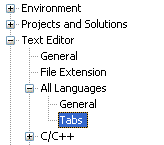

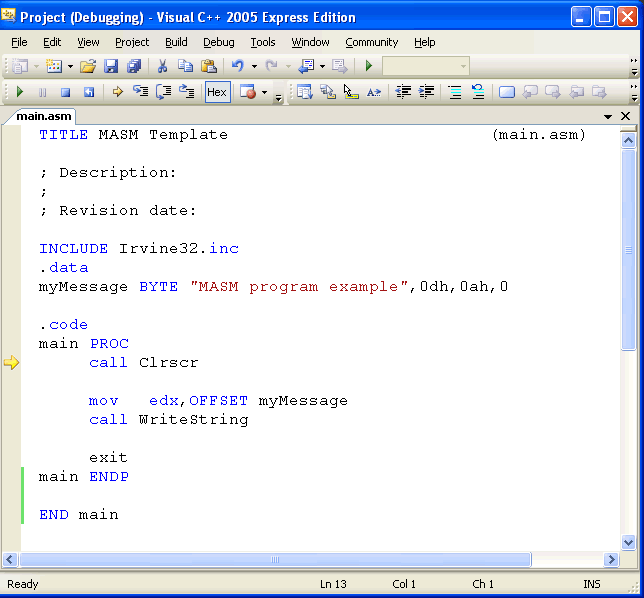

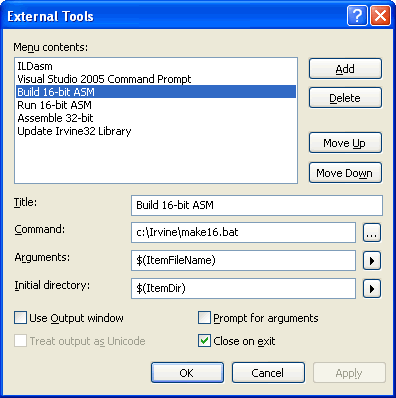
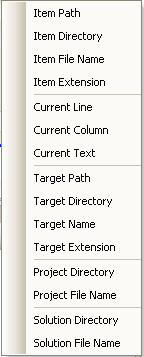
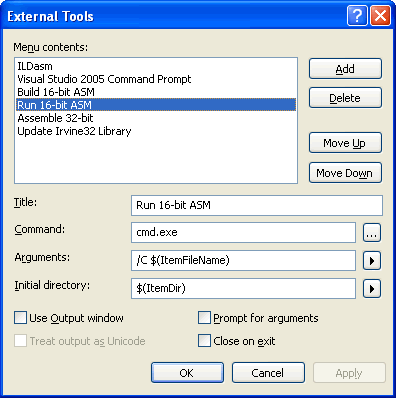
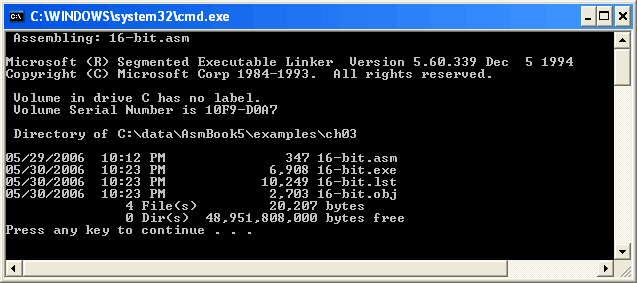



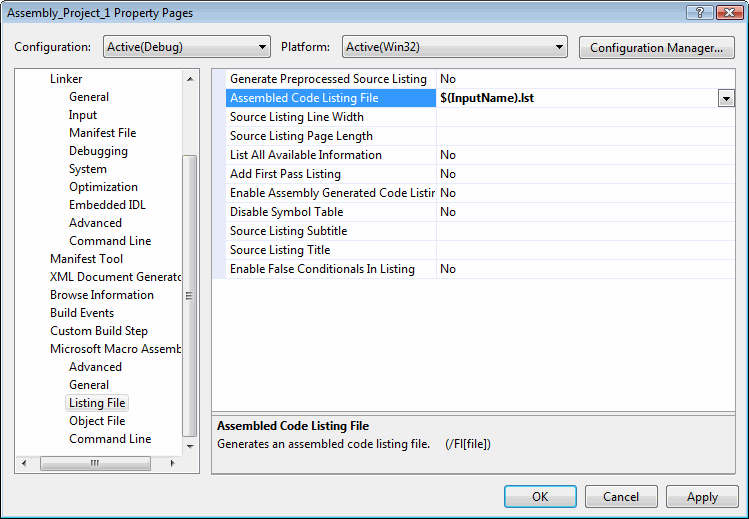

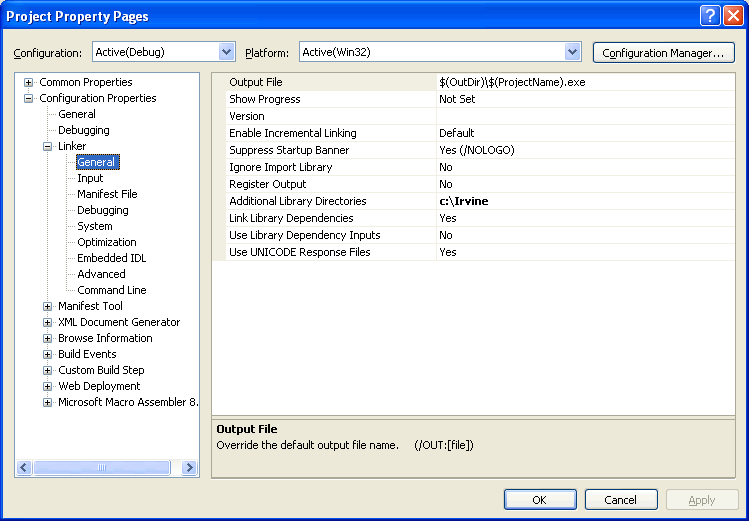

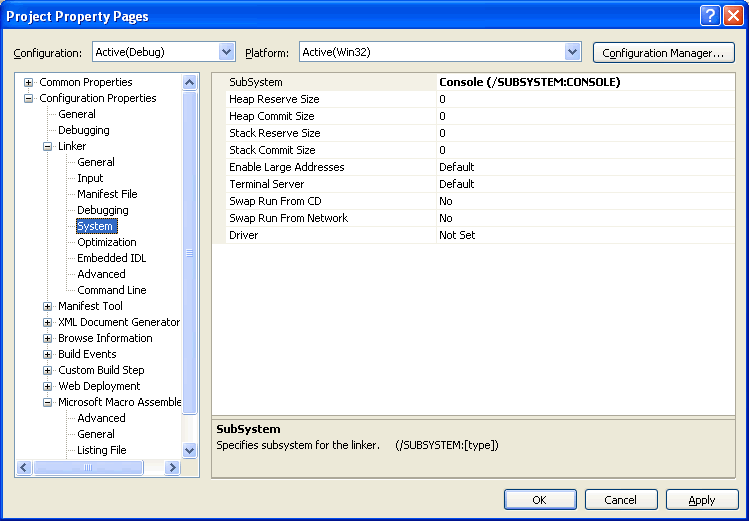
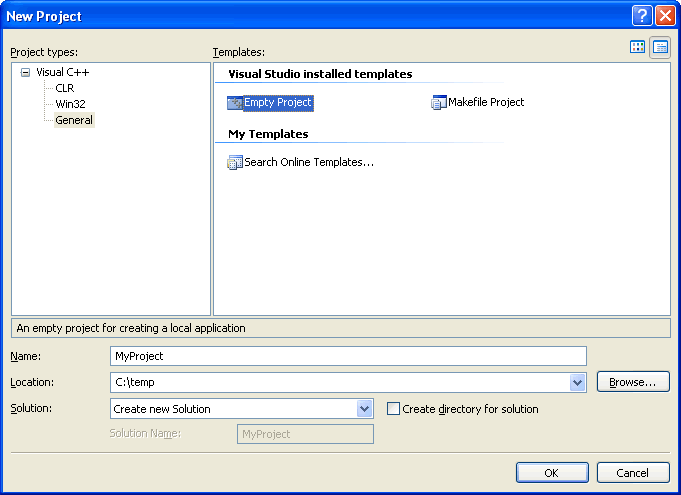
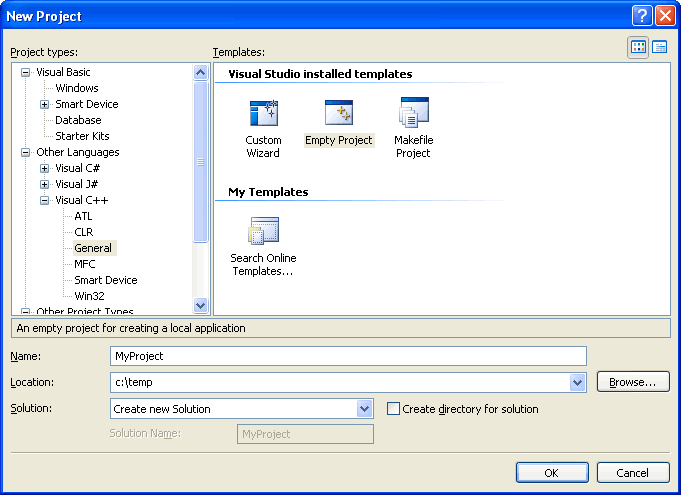
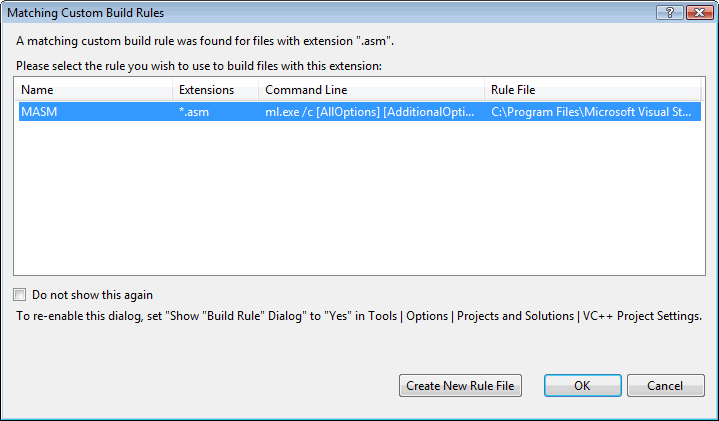 Then, proceed directly to Step 4.
Then, proceed directly to Step 4.
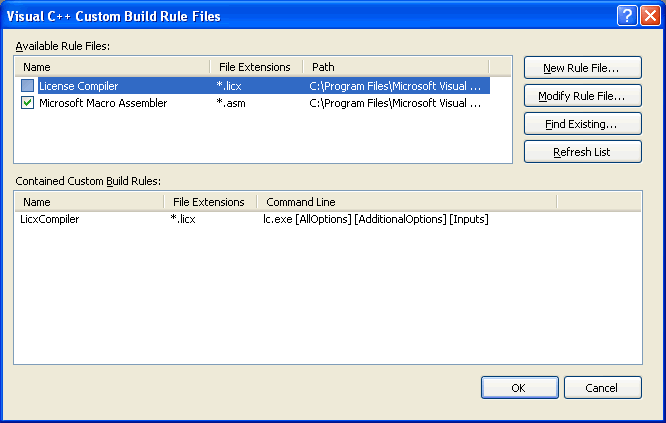
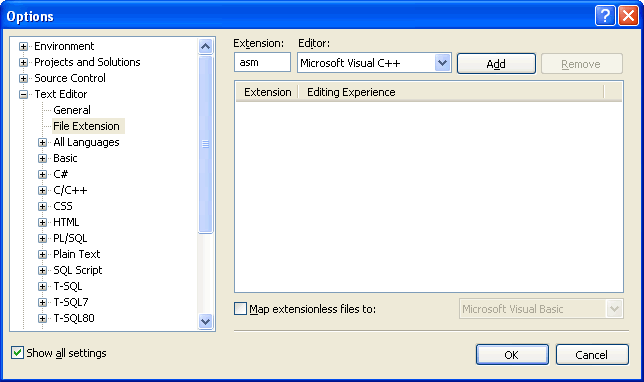
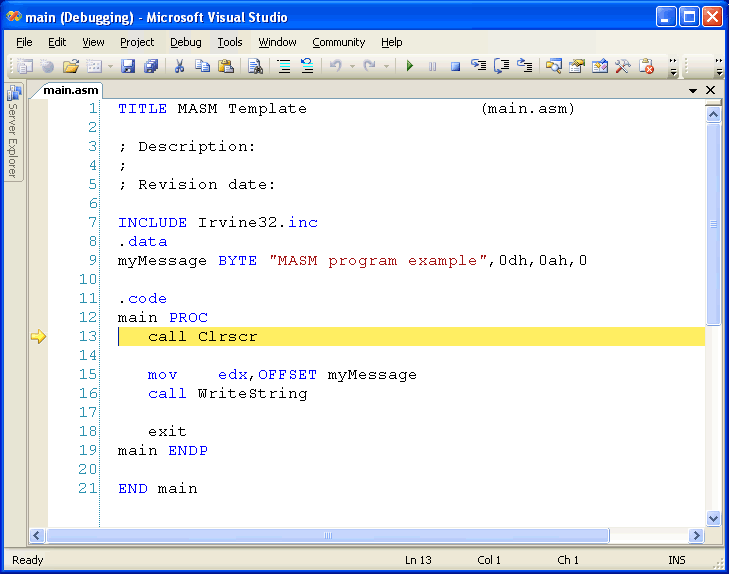














 1万+
1万+

 被折叠的 条评论
为什么被折叠?
被折叠的 条评论
为什么被折叠?








